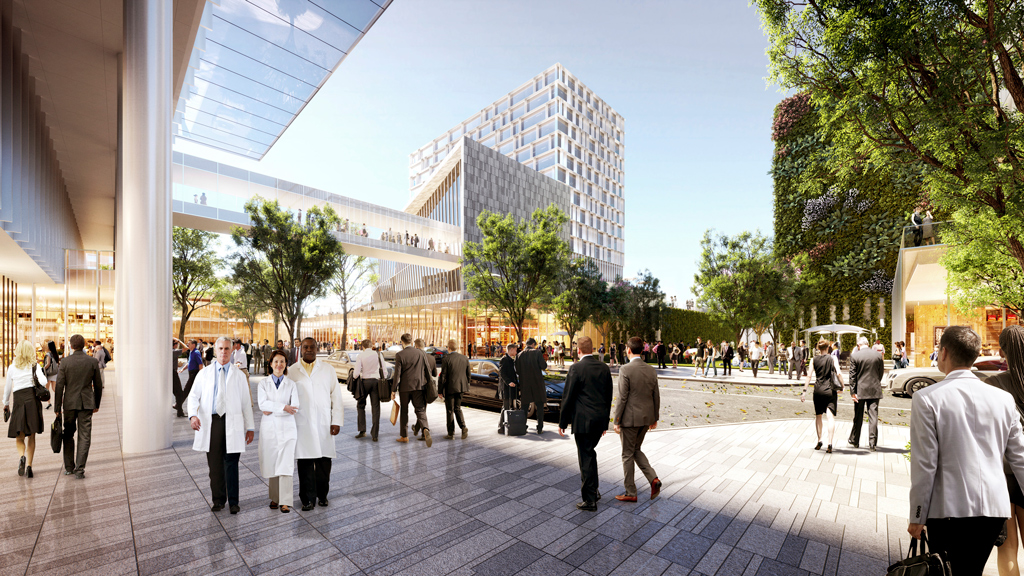How to Design Hospital-Ready Hotels
May 13, 2020 | By Randy Guillot and Steven R. Upchurch
Editor’s Note: This post is part of our ongoing exploration of how design is responding to the COVID-19 pandemic.
From late February to early May of this year, occupancy rates in the top 25 U.S. urban hotel markets dropped from 70% to below 30%, according to Smith Travel Research. With so much uncertainty around the globe, it’s clear the hospitality industry must reinvent itself if it is to survive in the emerging future.
In New York City, one of the hardest hit by the pandemic, the U.S. Army Corps of Engineers deployed a system in March that allows contractors to convert nearly any hotel room, dorm room, or convention center into a makeshift hospital.
In fact, the pandemic has proven that hotels can play an essential role beyond temporary hospital space. They can also serve as recovery facilities for healthcare workers to rest, shower, eat, and do laundry before they go home or provide temporary lodging for caregivers who may be working far from home or otherwise limiting their contact with others.
Now, many hospitality clients are asking how they can best design new properties or retrofit existing ones in order to safely support business and leisure travel while also finding a way to support medical personnel or non-acute patients in the event of another surge or crisis.
While the path forward is unique to each client, we’ve assembled a list of common considerations that will help owners, operators, and developers understand how to best adapt in the face of these new challenges.
1. Site selectionWhen evaluating a hotel property for its ability to support healthcare needs, consider four key factors:
- Agility: What is the speed to market? Does it have adequate capacity? Can elevators and corridors accommodate stretchers?
- Infectious Disease Control: Can you easily reconfigure ventilation for negative pressure? (Negative pressure is an isolation technique used in hospitals and medical centers to prevent cross-contamination from room to room). Are there adequate staff support areas?
- Integrated Continuum of Care: Is the site close to and/or connected to a medical facility? Can you host caregivers?
- Supporting Broader Care: Can you support oxygen tubing into the rooms? Is there a possibility of quickly installing a generator? How can existing amenities such as food facilities, conference rooms, laundry, loading dock and parking areas support care?
When evaluating an existing portfolio or scouting new hotel properties, look for those close to hospitals or medical campuses. Hotels within walking distance of healthcare sites or connected via public transportation offer convenience and accessibility for patients, medical personnel, and visitors.
The proposed Dallas Medical Research Park at Parkland is one such example. The master plan calls for two hotels within a visionary campus surrounded by significant medical institutions, including the University of Texas Southwestern Medical Center and other specialty care hospitals.
One hotel is planned with direct connectivity to one of the hospitals via an existing pedestrian bridge. The hotel will provide comfortable accommodations to the public, for families of patients, and to visiting doctors and nurses.
3. Alternative revenue optionsIn the event of a regional, national, or global disaster, properties must first take into account how long normal operations could potentially be impacted by the crisis. While evaluating alternative revenue sources, such as housing for governmental, construction, or medical groups, clients must also look at the spaces being utilized, the impact on hard and soft goods, insurance coverage, indemnification obligations, and the possible disruption of ongoing maintenance and operations.
4. Convertible spaces for care settingsExplore how conference and meeting spaces can be designed to quickly shift to a staging area for medical equipment, support area for caregivers, or a tent hospital site. How can guest rooms be safely converted to accommodate non-acute patients?
At a minimum, be mindful of these factors in room conversions:
- Contact surfaces: Minimize touch points like door locks and install wireless nurse call and cameras.
- Double occupancy: In the case of a surge in capacity, install cleanable partitions to subdivide rooms, while avoiding curtains.
- Mold and disruption: Consider replacing carpet or using a simple covering to mitigate disruption.
- Protection for the care team: Beyond hand sanitizers, add sinks in the corridor or janitors’ closets, if possible. Delineate areas for putting on and removing protective gear in spaces near the elevators.
- Ventilation: Look for direct room exhaust potential to accommodate negative pressure and HEPA filtering.
Hotel food facilities are a tremendous resource that can be converted nimbly to support emerging needs in times of crisis.
While hotel bars and restaurants may need to be shut down and cordoned off, provisions can be made to keep the back of the house spaces and kitchens functioning. These areas can provide room service, serve healthcare workers and potentially patients. Other options include opening kitchens to offer daily meals for hotel employees and local communities in need.
6. A greater emphasis on health and wellnessAs people return to hotels, they will expect much more attention paid to cleaning and hygiene routines, which is also critical for hotel employees to feel safe and comfortable. Leveraging mobile devices to manage check-in, room service, payments, and room access to will become commonplace. Voice and motion activated control systems to eliminate touching elevator buttons, doors, faucets, and other surfaces will become the new standard.
Industry leaders, developers, and designers should also consider using countertop, flooring, and wall surface materials that can be effectively cleaned. It’s also important to revisit mechanical systems to better understand how to improve air quality and circulation. Our clients continue to explore mechanical systems that help reduce contaminants in the breathing space and work to break down contaminants and pollutants.
Many owners and operators are turning to international advisory councils, such as the Global Biorisk Advisory Council, for guidance on operation and sanitation procedures with a focus on preparation, response, and recovery — drawing from those developed for airports, emergency medical services, law enforcement, and school campuses.
7. An opportunity for necessary improvements.Today’s low occupancy rates make for an unprecedented moment to move on building upgrades with marginal operational impact. In places where construction is allowed, many operators are considering completing renovations that are typically delayed due to high occupancy. Getting ahead of the return of customer traffic means they can implement new management, MEP, and wellness systems into their re-opening planning.
On a longer timeline, as hotel operators survey the needs for older facilities or look ahead to new construction, it will be important to consider how to best redirect funds to address on-site health, safety, and wellness priorities.
The hospitality industry cannot remain stagnant. Guests and the broader community will demand trustworthy spaces where they can feel safe and healthy. Beyond the mandate to ensure health and wellness, this is an opportunity to reimagine hotel spaces and design them to be responsive in times of need.
For media inquiries, email .


